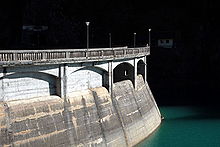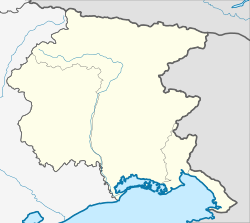Sauris
Sauris
Zahre(German) | |
|---|---|
| Comune di Sauris | |
 Sauris di Sotto | |
| Coordinates:46°28′N12°43′E/ 46.467°N 12.717°E | |
| Country | Italy |
| Region | Friuli-Venezia Giulia |
| Province | Udine(UD) |
| Frazioni | Sauris di Sotto (municipal seat), Sauris di Sopra, Lateis, La Maina, Field/Velt |
| Government | |
| • Mayor | Stefano Lucchini |
| Area | |
| • Total | 41.4 km2(16.0 sq mi) |
| Elevation | 1,212 m (3,976 ft) |
| Population | |
| • Total | 421 |
| • Density | 10/km2(26/sq mi) |
| Demonym | Saurani |
| Time zone | UTC+1(CET) |
| • Summer (DST) | UTC+2(CEST) |
| Postal code | 33020 |
| Dialing code | 0433 |
| Website | Official website |
Sauris(German:Zahre) is acomune(municipality) in theRegional decentralization entity of Udinein theItalianregion ofFriuli-Venezia Giulia.At an elevation of 1,212 m (3,976 ft), it is the second highest municipality in the region and one of the Germanlanguage islandsinNortheast Italy.Sauris is part of theAlpine pearlscooperation forsustainable tourism.
Geography
[edit]


Sauris is situated within theCarniamountain area ofFriuli,in the Lumiei Valley (Val Lumiei) of theCarnic Alps,northwest of theMonte Bìveramassif. It is located about 60 kilometres (37 mi) northwest of the provincial capitalUdineand 120 kilometres (75 mi) northwest ofTrieste.
The municipal area mainly consists of two villages, Sauris di Sotto (Unterzahre) und Sauris di Sopra (Oberzahre), with a total population of 429 (as of 2010[update]). Sauris borders the following municipalities:Ampezzo,Forni di Sopra,Forni di Sotto,Ovaro,Prato Carnico,andVigo di Cadore.
History
[edit]According to legend, the settlement was founded about 1300 by two exhausted German mercenaries who retired to Carnia. Actually, theRomanceplace nameSauris,possibly derived fromIllyrianSavira( "current" ), was already mentioned in the 12th century. German peasants probably immigrated from the TyroleanHochpustertaland the adjacentLesachtalin the north. Like the historicCadoreregion in the west, Carnia had belonged to the ecclesiasticalPatria del Friuli(Patriarchate of Aquileia) since 1077 and passed from theHoly Roman Empireto theRepublic of Veniceby 1420. For centuries, the isolated valley could only be reached by steep footpaths. A road to Ampezzo was built from 1919 to 1934; followed by the construction of a largedamproject in the Lumiei Valley from 1941 onwards. The Lago di Sauris reservoir was completed in 1948. During the period ofItalian Fascism,the local population was subject toItalianizationmeasures.
Language
[edit]Since its foundation, Sauris has been a German linguistic enclave in Friuli and has been able to preserve that status to the present day because of its isolated location. The local dialect,Saurano,preserves archaic features of theTyroleandialect to which it is related. This vernacular is a variety ofPuster ValleyTyroleanBavarianthat is closely related to the speech of nearbySappada(Plodn). It is unrelated to the GermanicCimbrian languagespoken in other language islands inTrentinoand Veneto. The population of Sauris is in large part trilingual, also able to speak Italian andFriulian.
The municipality falls under article 29 of the Regional Law of 18 December 2007 concerning Friulian, under which the Region of Friuli-Venezia Giulia established official nomenclature in both standard Friulian and the local forms of Friulian of those municipalities in which Friulian is ade factolanguage,[4]and also the regional laws 4/99 and 20/2009, establishing linguistic minority rights and aid for the German-speaking populations within Friuli-Venezia Giulia.[5]
References
[edit]- ^"Superficie di Comuni Province e Regioni italiane al 9 ottobre 2011".Italian National Institute of Statistics.Retrieved16 March2019.
- ^All demographics and other statistics: Italian statistical instituteIstat.
- ^"Popolazione Residente al 1° Gennaio 2018".Italian National Institute of Statistics.Retrieved16 March2019.
- ^Risorse: Toponomastica,Agjenzie Regjonâl pe Lenghe Furlane, Regione autonoma Friulia Venezia Giulia, retrieved 5 May 2013(in Italian)
- ^Una regione multilingue,Agjenzie Regjonâl pe Lenghe Furlane, Regione autonoma Friulia Venezia Giulia, retrieved 5 May 2013(in Italian)
External links
[edit]- (in Italian)Municipal site
- (in Italian)Tourist website




